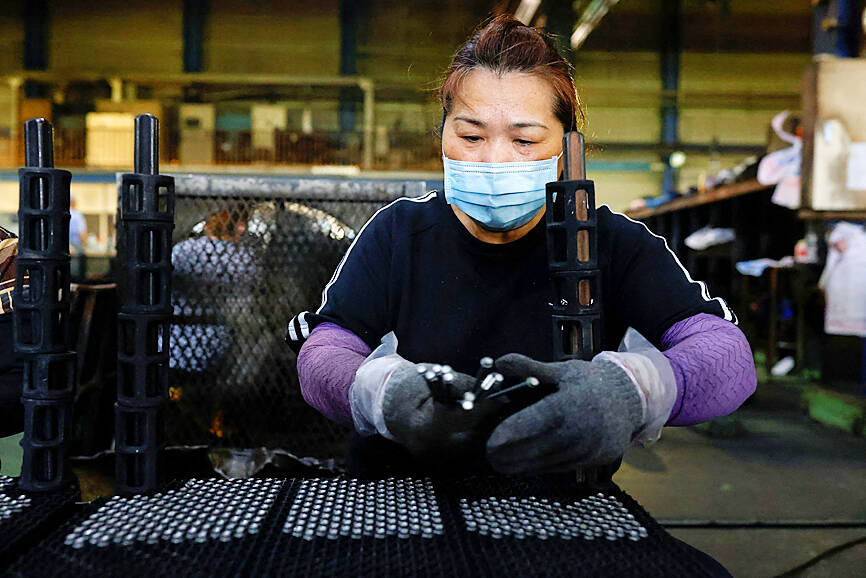The business climate monitor for local manufacturing in February signaled “blue” for a fourth consecutive month, reflecting declines in the petrochemicals, plastic, metal and electronics sectors, while auto components held firm, the Taiwan Institute of Economic Research (TIER, 台灣經濟研究院) said yesterday.
The business composite index edged up 0.85 points to 10.49, stuck in a recessionary state, as selling prices shed another 0.29 points on the back of firms cutting prices to secure orders, while the operating environment, cost, demand and input showed little improvement, the Taipei-based think tank said.
TIER uses a five-color spectrum to capture the industry’s movements, with “red” indicating a boom, “green” suggesting a steady state and “blue” signifying a downturn. Dual colors indicate a transition to a better or worse condition.

Photo: Ann Wang, Reuters
China’s reopening gave local firms a breather, but with end-market demand remaining soft in the US and Europe, inventory adjustments continued, hampering local manufacturers’ willingness to buy and prepare materials used in production, the institute said.
Against this backdrop, the ratio of companies whose business contracted dropped from 73.52 percent in January to 43.34 percent in February, while companies whose business was flat increased from 3.96 percent to 13.1 percent, it said.
Only 1.46 percent of companies reported that business increased and none experienced a boom, it added.
Textile and paper product makers reported a decline in business, as brand customers stuck to cautious inventory management and refrained from placing orders, it said.
Petrochemical suppliers found support in selling prices after local firms reduced capacity by conducting annual maintenance, it said.
Nevertheless, the entry of new competitors and slack global demand translated into a double-digit percentage decline in orders, it said.
Metal product suppliers fared slightly better, but remained weak overall, as downstream customers prioritized digestion of inventories, such as steel, it said.
The conservative business outlook weighed on machinery equipment providers, although some benefited from technology upgrades and capacity expansion by local semiconductor firms, it said.
The business monitor flashed “yellow-blue” for local electronics firms, as servers and networking equipment picked up due to demand from China, the institute said, adding that it did not see a recovery in demand for flat panels, computers and peripheral products.
Makers of transportation tools bucked the downtrend and reported steady business, thanks to the release of new vehicle models and an easing of the chip supply crunch, it said.
As a result, the number of new car license plates spiked 35.18 percent in January to 32,800 in February, it said.

Taiwan Semiconductor Manufacturing Co (TSMC, 台積電) last week recorded an increase in the number of shareholders to the highest in almost eight months, despite its share price falling 3.38 percent from the previous week, Taiwan Stock Exchange data released on Saturday showed. As of Friday, TSMC had 1.88 million shareholders, the most since the week of April 25 and an increase of 31,870 from the previous week, the data showed. The number of shareholders jumped despite a drop of NT$50 (US$1.59), or 3.38 percent, in TSMC’s share price from a week earlier to NT$1,430, as investors took profits from their earlier gains

In a high-security Shenzhen laboratory, Chinese scientists have built what Washington has spent years trying to prevent: a prototype of a machine capable of producing the cutting-edge semiconductor chips that power artificial intelligence (AI), smartphones and weapons central to Western military dominance, Reuters has learned. Completed early this year and undergoing testing, the prototype fills nearly an entire factory floor. It was built by a team of former engineers from Dutch semiconductor giant ASML who reverse-engineered the company’s extreme ultraviolet lithography (EUV) machines, according to two people with knowledge of the project. EUV machines sit at the heart of a technological Cold

Taiwan’s long-term economic competitiveness will hinge not only on national champions like Taiwan Semiconductor Manufacturing Co. (TSMC, 台積電) but also on the widespread adoption of artificial intelligence (AI) and other emerging technologies, a US-based scholar has said. At a lecture in Taipei on Tuesday, Jeffrey Ding, assistant professor of political science at the George Washington University and author of "Technology and the Rise of Great Powers," argued that historical experience shows that general-purpose technologies (GPTs) — such as electricity, computers and now AI — shape long-term economic advantages through their diffusion across the broader economy. "What really matters is not who pioneers

TAIWAN VALUE CHAIN: Foxtron is to fully own Luxgen following the transaction and it plans to launch a new electric model, the Foxtron Bria, in Taiwan next year Yulon Motor Co (裕隆汽車) yesterday said that its board of directors approved the disposal of its electric vehicle (EV) unit, Luxgen Motor Co (納智捷汽車), to Foxtron Vehicle Technologies Co (鴻華先進) for NT$787.6 million (US$24.98 million). Foxtron, a half-half joint venture between Yulon affiliate Hua-Chuang Automobile Information Technical Center Co (華創車電) and Hon Hai Precision Industry Co (鴻海精密), expects to wrap up the deal in the first quarter of next year. Foxtron would fully own Luxgen following the transaction, including five car distributing companies, outlets and all employees. The deal is subject to the approval of the Fair Trade Commission, Foxtron said. “Foxtron will be